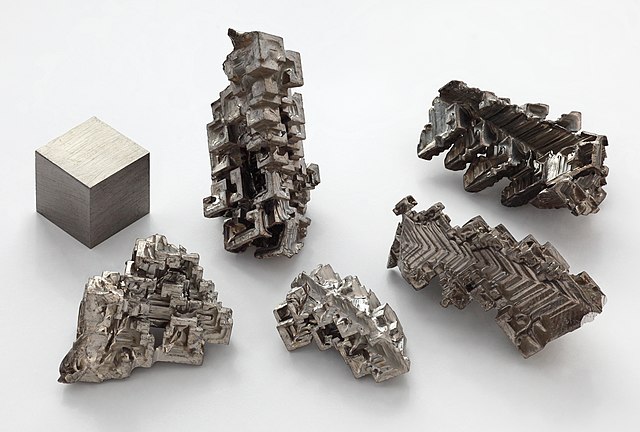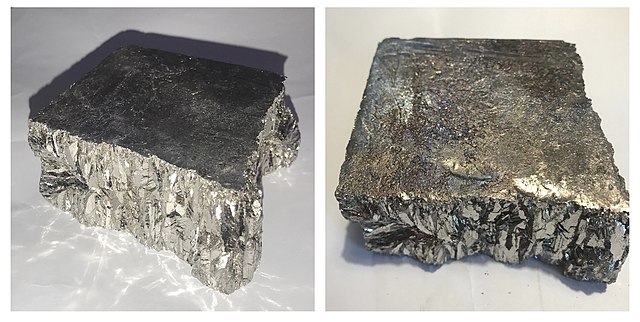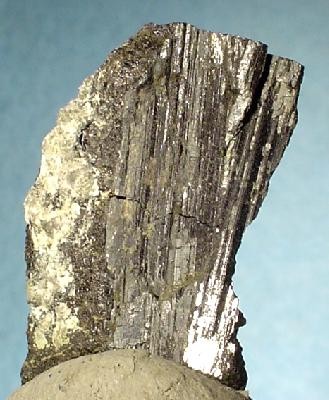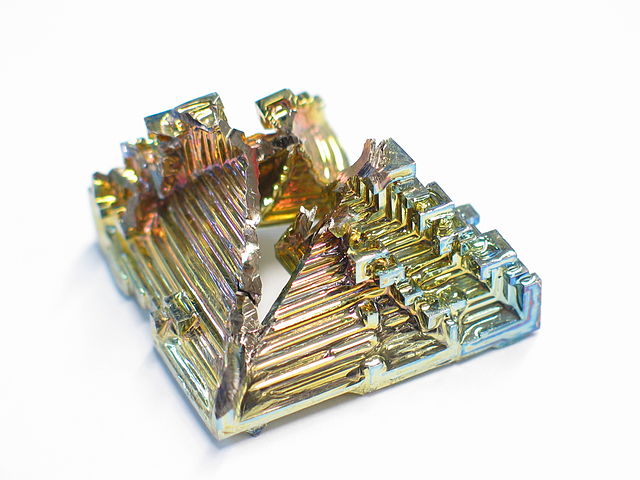Bismuth is a chemical element with the symbol Bi and atomic number 83. It is the heaviest element in the carbon family and is one of the few non-toxic elements.
It is frequently classified as a semi-metal or metalloid but has some unique characteristics that make it stand out from other elements in its group.
Bismuth has a variety of properties that make it both practical and interesting to study. Its atomic number is 83, placing it in the middle of the periodic table, and it’s melting and boiling points are surprisingly low compared to other elements in its group.
It is also relatively dense for its size and has some interesting chemical properties. Bismuth has a low thermal conductivity, making it a desirable material in many applications.

Wismut (Bi) Kristalle oxidfrei
Introduction
When it comes to its uses, bismuth has been employed in a variety of industries. It is a key component in lead-free solder, which is often used in electrical wiring and plumbing. It is also used in metallurgy, nuclear reactors, cosmetics, and pharmaceuticals. Bismuth has a wide range of applications, making it a valuable element in many industries.
The history of bismuth is just as fascinating as its properties and applications. It was first discovered in the 15th century and was named after the German word for “white mass” due to its unique color. Since then, bismuth has been used in many early industrial applications and continues to play a role in the modern world.
There are also some interesting facts about bismuth. It is one of the few non-toxic elements, meaning it is generally safe to ingest. The color of bismuth compounds can vary depending on the compound, and it has the lowest thermal conductivity of any element.
When it comes to health effects, bismuth is generally accepted as safe to ingest. However, there are potential side effects and risks associated with high levels of bismuth intake. Therefore, it is important to take safety precautions when handling bismuth and use it in accordance with the recommended guidelines.
Bismuth is certainly an interesting chemical element with many surprising characteristics. From its properties and applications to its history and health effects, bismuth has much to offer and deserves further exploration.
Properties of Bismuth
Bismuth is a chemical element that has a series of unique and interesting characteristics. Its atomic number is 83, and it is positioned in group 15 in the periodic table. Bismuth has a unique allotrope, which is an arrangement of its atoms, and also has a relatively low melting and boiling point.
It has a very low density when compared to other metals, and its strength is lower than many of its counterparts.
When it comes to the physical properties of bismuth, it has a lustrous white color that tarnishes slowly and is soft enough to be cut with a knife.
Bismuth has an unusual crystal structure, which helps to contribute to its low thermal conductivity. Its malleability and ductility are also quite low when compared to other metals.
Bismuth has a wide range of chemical properties. It is a brittle, lustrous metal that is notable for its considerable reactivity with both oxygen and water. It is also highly resistant to acids, but can be attacked by concentrated nitric and sulfuric acids. Bismuth is also one of the few elements that is non-toxic.
Not only is bismuth unique in its chemical and physical properties, but it also has many uses and applications. In metallurgy, bismuth is used in various alloys to help reduce the melting points of other metals. It is also used in nuclear reactors to help control corrosion and the accumulation of neutron radiation. It is also commonly used in the production of lead-free solders, and it has been used in cosmetics and pharmaceuticals.

Bismuth is an element that has been known and used for centuries. It was first discovered and named in the 15th century by Georgius Agricola, although its existence in nature was known long before that.
In the 19th century, bismuth began to be used in industrial applications such as lead-free solders and alloys. Since then, its use has continued to expand as more applications and uses have been discovered.
Bismuth also has some surprising characteristics. It has a relatively low melting and boiling point compared to other metals, and it has one of the lowest thermal conductivities of any metal. It is also one of the few non-toxic elements, making it safer to handle and use than many of its counterparts.
Bismuth is generally accepted as safe to ingest, though there are potential risks and side effects associated with its use. It is also important to take caution when handling bismuth, as it is highly reactive and can be attacked by various acids.
In conclusion, bismuth is a chemical element with a series of unique and surprising characteristics. It has a low melting and boiling point, a low density, and one of the lowest thermal conductivities of any metal. It has many uses and applications, including in metallurgy and alloys, nuclear reactors, lead-free solders, cosmetics, and pharmaceuticals.
Though generally safe to ingest, it is important to take caution when handling bismuth, as it is highly reactive and can be attacked by various acids.
Uses and Applications of Bismuth
Bismuth is a chemical element found naturally throughout the world that has many interesting and important uses. A main characteristic of bismuth is its low melting point and low boiling point, which make it a versatile material for many applications.
Bismuth has a wide range of uses and applications that span from metallurgy and nuclear reactors to cosmetics and pharmaceuticals.
In metallurgy and alloys, bismuth is used primarily to create low-temperature alloys with other metals or elements. It is commonly added to tin, lead, and other metals to make them less brittle and easier to form.
Bismuth has a low melting point, and when added to other metals it is much easier to shape and form them. This makes bismuth an ideal choice for creating alloys for commercial use in the production of various products.
Bismuth is also widely used as a neutron absorber in nuclear reactors. This is due to its ability to absorb neutrons from the reactor core, thereby allowing for better control over the reactor’s temperature and power. Additionally, it can be used to help slow the rate of a nuclear chain reaction.
Lead-free solder is another important use for bismuth. It is often used as a substitute for lead in solders due to its non-toxic properties and low melting point. This makes bismuth a safer alternative for use in electrical and plumbing applications, where lead solder is not recommended.
Bismuth is also found in a variety of cosmetics, such as eye shadow, blush, lip gloss, and mascara. It provides a soft, shimmery look to these products. Its low melting point also helps keep the product from melting on the skin.
Finally, bismuth is used in a variety of pharmaceuticals. Bismuth subsalicylate, which is found in Pepto-Bismol and other medications, is a common form of bismuth used to treat stomach ailments such as diarrhea and nausea. Bismuth is also used in some antibiotics to help treat gastrointestinal tract infections and Helicobacter pylori.
These are just some of the many uses and applications of bismuth. Its unique chemical properties make it a versatile and useful element in many industries.
From its use in alloys to its role in pharmaceuticals, bismuth is an element that has a variety of surprising and beneficial applications.

History of Bismuth
The element bismuth, with the atomic number 83, was discovered and named in 1753 by the French chemist Claude François Geoffroy. Prior to this, bismuth was mistakenly thought to be either lead or tin. It was not until 1789, when Antoine Lavoisier formally classified bismuth as an element, that it was fully understood and accepted.
During the Industrial Revolution, bismuth was heavily used in metallurgical processes such as refining copper and the production of brass and bronze. Its use decreased in the early 20th century, however, when it was replaced by other elements such as lead.
In the modern era, bismuth is used primarily in nuclear reactors. It is also used in lead-free solders, in cosmetics, and in pharmaceuticals. Bismuth is known for its slow-acting and long-lasting effects, so it is an ideal choice for medical applications.
The compound bismuth oxide (Bi2O3) is produced from ore bismuthinite and is used in the production of certain glass and ceramic colors. Bismuth oxychloride, in turn, is used in cosmetics such as blushes and eyeshadows.
Bismuth is also a key component of many alloys, including bismuth-tin alloys for electrical contacts and bismuth-antimony alloys for typecasting and plastic molding. These alloys have much lower melting points than pure bismuth, making them easier to handle and shape.
Bismuth is also used in industrial catalysts, in which it helps to remove sulfur and nitrogen compounds from exhaust gases. Its low toxicity makes it an ideal choice for catalytic converters.
Finally, bismuth is also used in the production of radiation-shielding materials such as lead-bismuth eutectic alloys. These alloys are used in medical applications such as protecting patients from radiation exposure during medical imaging and in nuclear power plants.
In conclusion, bismuth has a long and varied history. It was discovered and named in 1753 and has since been used in metallurgy and alloys, nuclear reactors, lead-free solder, cosmetics, pharmaceuticals, industrial catalysts, and radiation-shielding materials. It’s varied properties and low toxicity make it a versatile and valuable element.
Interesting Facts About Bismuth
Bismuth is an amazing and surprising chemical element, with a wide range of applications and interesting facts. One of the most interesting facts about this element is that it is one of the few non-toxic elements. This means that it can be ingested in small doses with no adverse health effects.
Another interesting fact about bismuth is the color of its compounds. While its pure form is a silvery-white metallic color, the compounds of bismuth are some of the most colorful in the world. This is due to the presence of bismuth oxychloride and other bismuth compounds, which can range from a pink hue to bright blues and greens.
Bismuth also has the unique distinction of having the lowest thermal conductivity of any metal. This means that it is an effective insulator, able to retain heat and keep it from traveling. This makes it ideal for use in the construction of insulating materials.

When it comes to its physical properties, bismuth has an atomic number of 83, and is a chemical element in the periodic table. In its solid form, its boiling point is 544.7°C and its melting point is 271.3°C. Bismuth also has a density of 9.78 grams per cubic centimeter. Additionally, it is one of the few metals that is not affected by air or water.
Bismuth also has some interesting chemical properties. It is an element that is highly reactive, and can easily form a variety of compounds. It has a high affinity for oxygen and sulfur, and it can form complexes with many other elements. This makes it a versatile and essential element for a wide range of applications.
In conclusion, bismuth is a unique and surprising element with a wide range of properties and applications. Its non-toxic nature makes it safe to ingest in small doses, and its low thermal conductivity makes it an effective insulator. Its impressive chemical properties give it a wide range of uses, and its compounds offer a multitude of colors.
While it can be dangerous to handle in large quantities, bismuth is an essential and versatile element that is essential to the modern world.
Health Effects of Bismuth
Bismuth is generally accepted as safe to ingest, making it a useful element in many pharmaceuticals. In fact, it has been approved as a food additive in the EU and other countries since the 1980s. As with any chemical element, however, there are potential side effects and risks associated with its use.
In humans, exposure to bismuth can result in minor skin and eye irritation, nausea, and dizziness. The element is rarely found in nature and, as such, direct exposure is unlikely. For this reason, there is little concern about acute toxicity from bismuth.
Long-term exposure to bismuth, however, can result in more severe health effects. This is because bismuth is a heavy metal with a tendency to accumulate in the body. In high doses, bismuth can cause serious health problems, such as kidney and liver damage, neurological disorders, and reproductive issues.
Bismuth is also toxic to the environment. It tends to accumulate in soil and water, leading to contamination and risk of poisoning to organisms living in these ecosystems. It is important to remember to dispose of bismuth-containing products properly to avoid potential contamination.
The use of bismuth in cosmetics and pharmaceuticals is highly regulated. In the EU, there is a strict limit on the amount of bismuth allowed in these products, and it is generally only used in very small doses.
To ensure safety when handling bismuth, it is important to wear protective clothing and a dust mask. Precaution should also be taken to avoid spills, as bismuth can be hazardous if ingested or exposed to skin and eyes.
Overall, bismuth is generally accepted as safe to ingest, and its use in small doses is well-regulated. However, there are still potential risks associated with long-term exposure or ingestion of large amounts of the element. For this reason, it is important to remember that caution should be taken when handling bismuth and to dispose of bismuth-containing products properly.
Facts
Bismuth is a chemical element with the symbol Bi
Its atomic number is 83.
Bismuth was discovered by Arabic alchemists prior to 1,000 AD.
Bismuth is a brittle metal with a dark, silver-pink hue
Bismuth is a solid at room temperature.
The word “bismuth” is a Latinized version of an Old German word, “weissmuth” or “white substance”
Bismuth is a period 6 chemical element, which is the sixth row on the periodic table.
Most common isotope is Bi-209
Bismuth ranks 65th in elemental abundance in the Earth’s crust
Bismuth is one of only a few elements whose liquid state has a higher density than its solid state.
Bismuth abundance in our solar system is 10 parts per billion by weight
bismuth has the highest electrical resistance, the lowest thermo-conductivity, and the highest Hall Effect.
Bismuth is a group 15 chemical element, which is the nitrogen group.
Bismuth is in the p-block on the periodic table of elements.
Bismuth metal has been known since ancient times
Bismuth is around twice as common as gold in the Earth’s crust.
China, Peru, and Mexico are the major suppliers of bismuth.
In the Earth’s crust, bismuth is about twice as abundant as gold.
The most important ores of bismuth are bismuthinite and bismite
The compound bismuth subsalicylate is used to prevent diarrhea.
Bismuth oxychloride is sometimes used in cosmetics, as a pigment in paint for eye shadows, hair sprays and nail polishes.
Almost 90% of the bismuth comes from China.
The U.S. imports about 80% of its bismuth from China.
Bismuth is typically obtained as a by-product in refining lead, copper, tin, silver, and gold ores.
Bismuth subsalicylate, sold under various brand names is a well-known remedy for stomach aches and diarrhea.
Information
| Bismuth | ||||||||||||||||||||||||||||||||||||||||
|---|---|---|---|---|---|---|---|---|---|---|---|---|---|---|---|---|---|---|---|---|---|---|---|---|---|---|---|---|---|---|---|---|---|---|---|---|---|---|---|---|
| Pronunciation | BIZ-məth | |||||||||||||||||||||||||||||||||||||||
| Appearance | lustrous brownish silver | |||||||||||||||||||||||||||||||||||||||
| Standard atomic weight Ar°(Bi) | ||||||||||||||||||||||||||||||||||||||||
|
||||||||||||||||||||||||||||||||||||||||
| Bismuth in the periodic table | ||||||||||||||||||||||||||||||||||||||||
| Atomic number (Z) | 83 | |||||||||||||||||||||||||||||||||||||||
| Group | group 15 (pnictogens) | |||||||||||||||||||||||||||||||||||||||
| Period | period 6 | |||||||||||||||||||||||||||||||||||||||
| Block | p-block | |||||||||||||||||||||||||||||||||||||||
| Electron configuration | [Xe] 4f14 5d10 6s2 6p3 | |||||||||||||||||||||||||||||||||||||||
| Electrons per shell | 2, 8, 18, 32, 18, 5 | |||||||||||||||||||||||||||||||||||||||
| Physical properties | ||||||||||||||||||||||||||||||||||||||||
| Phase at STP | solid | |||||||||||||||||||||||||||||||||||||||
| Melting point | 544.7 K (271.5 °C, 520.7 °F) | |||||||||||||||||||||||||||||||||||||||
| Boiling point | 1837 K (1564 °C, 2847 °F) | |||||||||||||||||||||||||||||||||||||||
| Density (near r.t.) | 9.78 g/cm3 | |||||||||||||||||||||||||||||||||||||||
| when liquid (at m.p.) | 10.05 g/cm3 | |||||||||||||||||||||||||||||||||||||||
| Heat of fusion | 11.30 kJ/mol | |||||||||||||||||||||||||||||||||||||||
| Heat of vaporization | 179 kJ/mol | |||||||||||||||||||||||||||||||||||||||
| Molar heat capacity | 25.52 J/(mol·K) | |||||||||||||||||||||||||||||||||||||||
Vapor pressure
|
||||||||||||||||||||||||||||||||||||||||
| Atomic properties | ||||||||||||||||||||||||||||||||||||||||
| Oxidation states | −3, −2, −1, 0,[2] +1, +2, +3, +4, +5 (a mildly acidic oxide) | |||||||||||||||||||||||||||||||||||||||
| Electronegativity | Pauling scale: 2.02 | |||||||||||||||||||||||||||||||||||||||
| Ionization energies |
|
|||||||||||||||||||||||||||||||||||||||
| Atomic radius | empirical: 156 pm | |||||||||||||||||||||||||||||||||||||||
| Covalent radius | 148±4 pm | |||||||||||||||||||||||||||||||||||||||
| Van der Waals radius | 207 pm | |||||||||||||||||||||||||||||||||||||||
|
|
||||||||||||||||||||||||||||||||||||||||
| Other properties | ||||||||||||||||||||||||||||||||||||||||
| Natural occurrence | primordial | |||||||||||||||||||||||||||||||||||||||
| Crystal structure | rhombohedral | |||||||||||||||||||||||||||||||||||||||
| Speed of sound thin rod | 1790 m/s (at 20 °C) | |||||||||||||||||||||||||||||||||||||||
| Thermal expansion | 13.4 µm/(m⋅K) (at 25 °C) | |||||||||||||||||||||||||||||||||||||||
| Thermal conductivity | 7.97 W/(m⋅K) | |||||||||||||||||||||||||||||||||||||||
| Electrical resistivity | 1.29 µΩ⋅m (at 20 °C) | |||||||||||||||||||||||||||||||||||||||
| Magnetic ordering | diamagnetic | |||||||||||||||||||||||||||||||||||||||
| Molar magnetic susceptibility | −280.1×10−6 cm3/mol | |||||||||||||||||||||||||||||||||||||||
| Young’s modulus | 32 GPa | |||||||||||||||||||||||||||||||||||||||
| Shear modulus | 12 GPa | |||||||||||||||||||||||||||||||||||||||
| Bulk modulus | 31 GPa | |||||||||||||||||||||||||||||||||||||||
| Poisson ratio | 0.33 | |||||||||||||||||||||||||||||||||||||||
| Mohs hardness | 2.25 | |||||||||||||||||||||||||||||||||||||||
| Brinell hardness | 70–95 MPa | |||||||||||||||||||||||||||||||||||||||
| CAS Number | 7440-69-9 | |||||||||||||||||||||||||||||||||||||||
| History | ||||||||||||||||||||||||||||||||||||||||
| Discovery | Arabic alchemists (before AD 1000) | |||||||||||||||||||||||||||||||||||||||
|
||||||||||||||||||||||||||||||||||||||||
